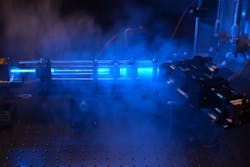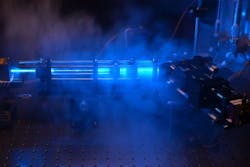Shoebox-sized, inexpensive, and automated flow cytometer counts cancer cells in blood
Recognizing that large flow cytometers are expensive and can only be operated by trained personnel, researchers at the Fraunhofer Institute for Chemical Technology (ICT-IMM; Mainz, Germany) have developed a version that is cheap to produce, no bigger than a shoebox, and automated for counting cancer cells.
Related: Instrumentation advances add flexibility and quantitation to flow cytometry
The PoCyton flow cytometer takes a sample of the patient's blood and, within a short time, the attending physician will know how many tumor cells are circulating in the blood. Cancerous growths release cells into the bloodstream and their number provides an indication of how effective the therapy has been. If the number of cancerous cells decreases in the course of treatment, it shows that it has been effective.
Existing flow cytometers are capable of measuring the quantity of tumor cells circulating in the bloodstream, but they often cost up to $334,000 (€300,000) and take up an amount of space equivalent to two washing machines—plus the test cycle lasts several hours. In contrast, the PoCyton device enables such tests to be carried out around 20 times faster, according to Dr. Michael Baßler, research scientist at ICT-IMM. Additional advantages include the use of miniaturized components to reduce its size to that of a shoebox and automated measurements without the need for calibration.
In flow cytometry, a fluorescent dye is injected into the blood and the dye molecules bind to the tumor cells, leaving all other cells unmarked. Until now, the physician had to add the dye to the blood sample manually, which now takes place automatically in the PoCyton process. The blood is funneled through a narrow focal area, causing all suspended cells to pass one by one in front of a laser spot detector. The light causes the cancer cells to which the dye has attached itself to fluoresce, enabling the device to detect and count them. This narrow passage is the key to the PoCyton process. At the same time, its geometry was chosen to ensure that no cells pass in front of one another. In this way, the scientists can be sure that the system registers every single object flowing past the detector—and that no cell is hidden behind another. Such errors could have dramatic consequences because a 10 mL sample of blood contains around one billion suspended objects. Of these, only five are circulating tumor cells—even in a severely sick patient. The researchers have mastered the individual steps such as adequate sensitivity, automatic sample preparation, and analysis, and are now combining them to create a fully functional prototype by the summer of 2015.
Additional applications for the PoCyton could be detection of legionella bacteria in drinking water, which can cause the sometimes-deadly lung infection known as Legionnaire's disease.
For more information, please visit www.fraunhofer.de.
Follow us on Twitter, 'like' us on Facebook, connect with us on Google+, and join our group on LinkedIn

